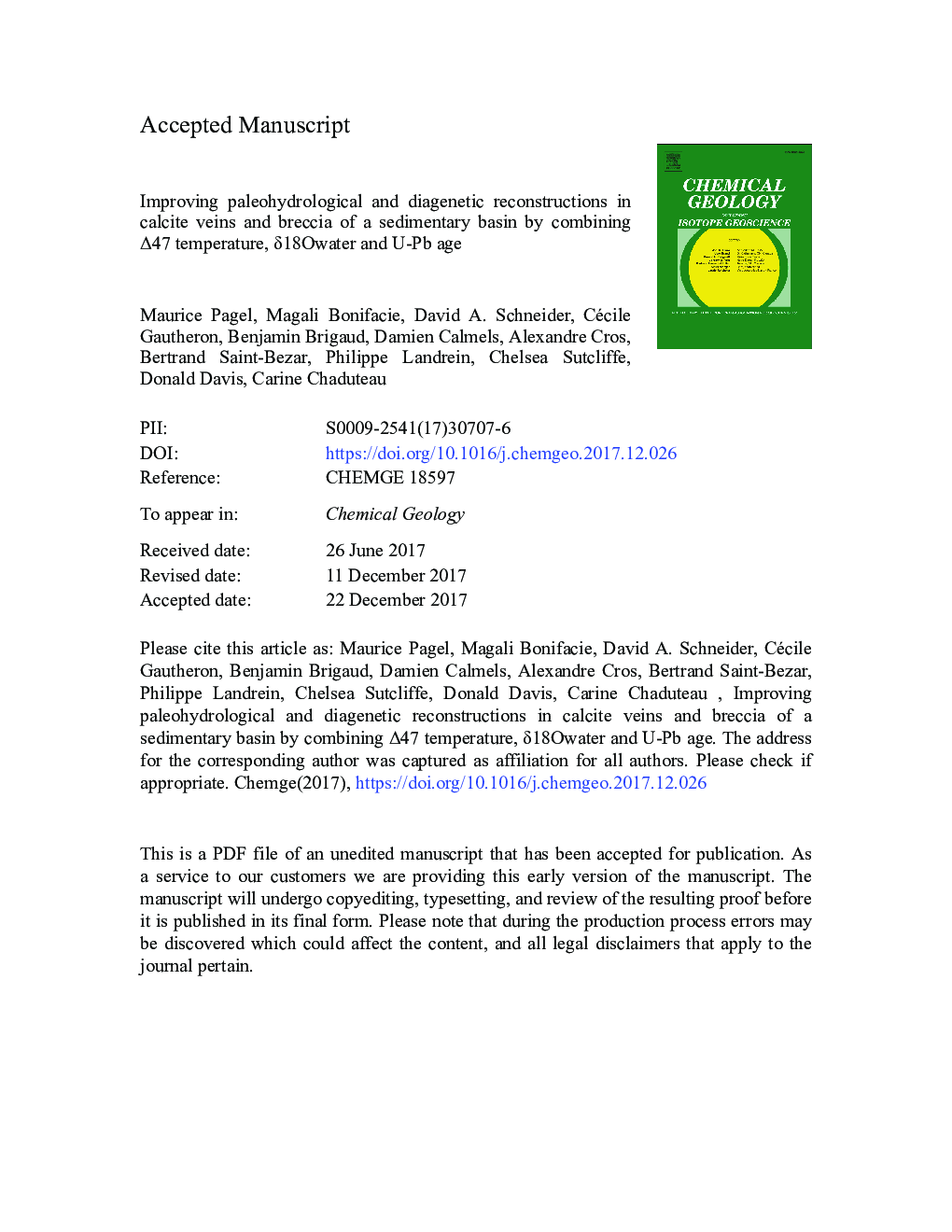| کد مقاله | کد نشریه | سال انتشار | مقاله انگلیسی | نسخه تمام متن |
|---|---|---|---|---|
| 8910327 | 1637493 | 2018 | 59 صفحه PDF | دانلود رایگان |
عنوان انگلیسی مقاله ISI
Improving paleohydrological and diagenetic reconstructions in calcite veins and breccia of a sedimentary basin by combining Î47 temperature, δ18Owater and U-Pb age
دانلود مقاله + سفارش ترجمه
دانلود مقاله ISI انگلیسی
رایگان برای ایرانیان
کلمات کلیدی
موضوعات مرتبط
مهندسی و علوم پایه
علوم زمین و سیارات
ژئوشیمی و پترولوژی
پیش نمایش صفحه اول مقاله

چکیده انگلیسی
In sedimentary basins, the precise temperature and timing at which relatively shallow (< 60 °C) diagenetic and tectonic events occur are poorly recorded by classic geothermometers and low-temperature thermochronometers. In this study, we apply a methodology coupling carbonate clumped isotope Î47 thermometry with U-Pb geochronology. Calcite breccias and veins from the border of the Gondrecourt graben (eastern Paris Basin, France), in Kimmeridgian limestones, were observed by optical microscopy and cathodoluminescence. They display Î47 values that are identical within uncertainties (ranging from 0.621 to 0.635â°), implying very uniform calcite deposition temperatures averaging 44 ± 4 °C for the three investigated zones. When Î47 temperatures are combined with the measured oxygen isotope composition of the calcite (δ18Ocal between â 9.0â° and â 8.3â°V-PDB), one can calculate the δ18O of the water (δ18Owater) from which these cement breccia and vein calcite precipitated. The δ18Owater are very uniform (average of â 4.5 ± 1â°V-SMOW) and overall are consistent with a meteoric origin, however with a slight 18O-enrichment via interaction with limestones prior to precipitation. U-Pb dating by LA-ICP-MS yields a model age for three hydraulic breccias at 43-42 Ma and an age at 35 Ma for calcite veining obtained from a single vein sample. When considering the geothermal gradient, the surface temperature during the Eocene and erosion, the temperatures obtained by Î47 thermometry suggest that there were hot waters circulating from the Middle Jurassic sequences below. Additional geochemical data (δ18Ocal, δ13Ccal, Rare Earth Elements, Mg, Mn and Sr compositions from a larger set of calcite breccias and veins from the area, together with published δD values of fluid inclusions) allow further characterization of the fluid from which the calcite phases precipitated. Notably, the whole suite of calcite shows a slight decrease in both δ18Ocal and δ13Ccal (δ18Ocal between â 8.3â° and â 9.9â°V-PDB, δ13Ccal between 2.9â° and 0.9â°V-PDB) and in Mg and Mn contents from breccia to veins, indicative of higher water:rock ratios during the vein stage and leaching of different source limestones. More broadly, this study demonstrates the potential improvement in diagenetic and paleohydrological research by combining U-Pb dating from the same calcite crystals as those analyzed for stable and clumped isotopes.
ناشر
Database: Elsevier - ScienceDirect (ساینس دایرکت)
Journal: Chemical Geology - Volume 481, 20 March 2018, Pages 1-17
Journal: Chemical Geology - Volume 481, 20 March 2018, Pages 1-17
نویسندگان
Maurice Pagel, Magali Bonifacie, David A. Schneider, Cécile Gautheron, Benjamin Brigaud, Damien Calmels, Alexandre Cros, Bertrand Saint-Bezar, Philippe Landrein, Chelsea Sutcliffe, Donald Davis, Carine Chaduteau,